In The Beginning
I’ve been “into trains” since my pre-teen years, and a serious model railroader for over 40 years. Back in the late 1970s, I began searching for a prototype because it became clear to me from my reading that modeling an actual railroad offered a number of advantages over inventing one on my own. My childhood trains were American Flyer, and I had an affinity for the nice size of S scale trains (1:64), so I wanted to stay with S. While I had big dreams, as all modelers do when envisioning their ultimate layout, both space and funds were at a premium at that time, and so I knew I shouldn’t be looking at the big Class 1 railroads. Besides, I wanted to model a railroad that was, well, different from what other guys were doing.
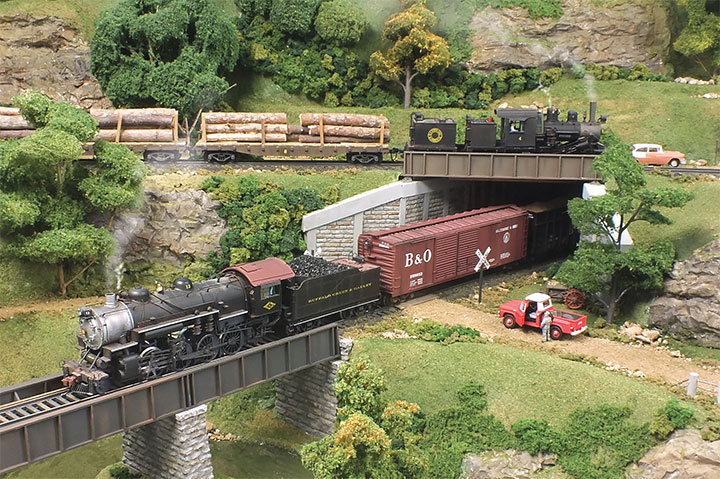
To make a long story short, with some help from my brother, who was living in West Virginia at the time, I discovered two railroads that were owned by the Elk River Coal & Lumber Company (ERC&L) and which were completely intertwined. You see, the ERC&L Co. operated a huge coal mine in central West Virginia, and also logged the 100,000 acres it owned around the mine. The first railroad, the Buffalo Creek and Gauley, was a standard gauge common carrier that hauled coal from the Rich Run Mine in Widen to an interchange with the B&O at Dundon, about 18 miles away. This interchange was the only connection the BC&G had with the outside world. In the 1950s and 60s, the BC&G rostered three Consolidations, and had a hodge-podge of secondhand MOW and passenger rolling stock typical of a short line. It was clear to me that the BC&G in this period would be a perfect railroad to model.
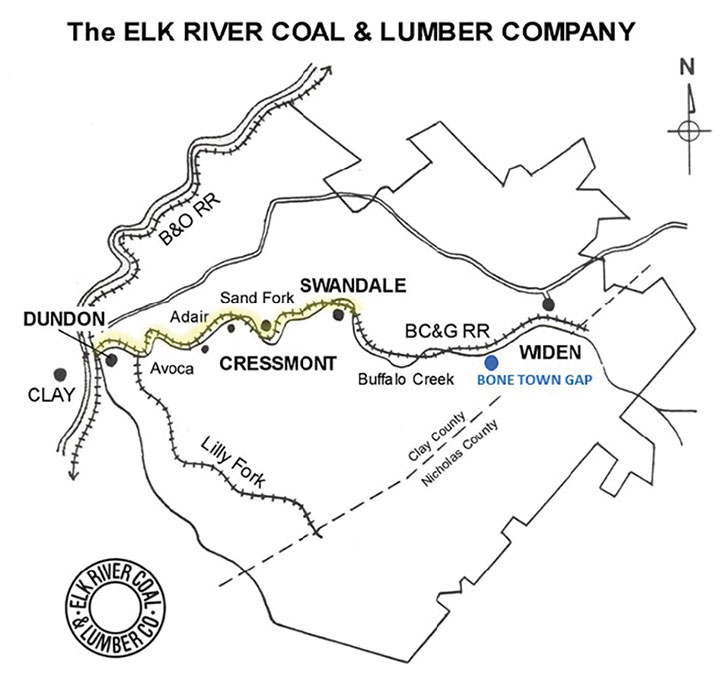
But the “cherry on top” resulting from selecting the BC&G as my prototype, is that the ERC&L Co. also used standard gauge geared locomotives lettered for the ERC&L to haul lumber from the woods to a big sawmill the company operated at Swandale, midway between Dundon and Widen. When I started, I had no idea how I’d model the geared engines in S scale, but I reasoned I had years to figure that out! The log trains ran from Swandale on BC&G track to a wye at Avoca, where light rail laid on hand-hewn log ties, ran 9 miles out into the woods. The complete story of the ERC&L Co. and the “two railroads for the price of one,” including hundreds of prototype photos selected expressly for modelers, is available on a website I maintain at www.buffalocreekandgauley.com.
First Three Layouts
Convinced I was on to something, I started my first S scale layout around 1980. It was crude, but I had a blast researching the railroads and cobbling together representations of the coal mine, the sawmill and the equipment of the two railroads. A second layout followed as the result of a move to a new home. Then a third layout was begun in 1998 after yet another move. This one filled a 44- x 25-foot room, and included all four of the towns served by the BC&G, the coal mine, the sawmill and the logging operation as well. For a long time, I substituted light Diesels for the geared logging engines, but by this time, S Helper Service had introduced beautiful S scale Consolidations which were perfect for the BC&G.
I hosted 50 operating sessions on the “big layout.” Each session engaged four 2-man crews for about 4 hours, during which time coal trains and log trains traveled through rugged mountain terrain that reached above the eye level of the operators. By most measures, the layout was complete and had served me, and those who saw and operated it, very well for nearly 20 years. But life events determined that it was time to move on. This layout was dismantled in 2016 for a move to a new, smaller retirement home. The layout was featured in the January/February 2013 GAZETTE, and is also documented on my BC&G website.
The New Layout
At age 70, I had some decisions to make about my involvement in the hobby. The relocation move presented a great opportunity to try something new on my fourth layout, and hopefully, do some things better. I thought through some options, but it didn’t take long to conclude that the most logical thing to do was to continue modeling the BC&G and ERC&L logging operation, and to do it in S scale. I simply had too much time and money invested to start over with a different prototype, or in a different scale. I was fortunate enough to be able to design a small layout room in our new home, but it was clear that something was going to have to be eliminated from the “big layout,” as the new space measured just 12 x 25 feet.
As it turns out, all I had to do was do what the prototype did, cut the railroad in half! After operating for fifty years, in December 1963, the Rich Run Mine closed. BC&G trains then needed to run only the 9 miles to Swandale, the site of the sawmill. The eastern-most 9 miles of track was no longer used. The geared logging engines continued to run along BC&G track, and then head off into the woods at Avoca. I developed a track plan on two levels with as long a mainline run as was practical in the space available. The focus of the layout is the switching operations at the Dundon interchange, the sawmill at Swandale, and at the log loading site out in the woods. The time period is the summer of 1964, the last summer of steam operations on the BC&G.

Layout Design Objectives
Four primary and inter-related objectives drove the design of the new layout:
Overall Visual Impact — The environment a layout is in can make or break it. I wanted the new layout to fit comfortably in the new space and for it to present a level of “visual drama.” More layout could have been put in the room, but I opted for plenty of open space for viewers and operators. The layout shares the room with a desk, shelves and bookcases so that my collection of memorabilia and reference material is close at hand.
Prototype Fidelity — After researching and modeling the BC&G and ERC&L logging activities for 40 years, I had lots of information about the railroads, the structures and the geography. I wanted to have the new layout be as representative of the prototype as it could be, given its compact size. I knew that significant compromises would be required, but I wanted to include as many prototype-inspired mini-scenes and details as I could. Every structure on the layout was scratchbuilt and represents a prototype structure. Equally important, was to have an operating scheme in which all the trains would be representative of trains that at one time or another ran on the real railroad.
Operating Fun — The track plan and operating scheme were developed simultaneously. This ensured that the locations and sizes of sidings, staging, and run around tracks would accommodate the trains I planned to run. While trains are shorter than on the large layout, and they travel less distance between work sites, operations are fun. Trains on the schedule include the Mack Railbus, the BC&G trains running between the interchange at Dundon and the sawmill, the log trains between Swandale and the log camp at Starcher, and the Climax-powered “steel train” moving supplies for the loggers. At the end of an operating session, time leaps ahead a few years and the Diesel powered coal trains that ran on BC&G trackage when the line reopened under new ownership in 1971 are run.
Photographic Opportunities — Sharing my modeling efforts with others through published photos has long been an enjoyable part of the hobby for me. I plan to continue to share the new layout in this way, and so as I laid out the track plan and scenery, I was sensitive to where the good “photo ops” would be. The layout room is brightly lit to facilitate taking photos without the need for auxiliary lighting.
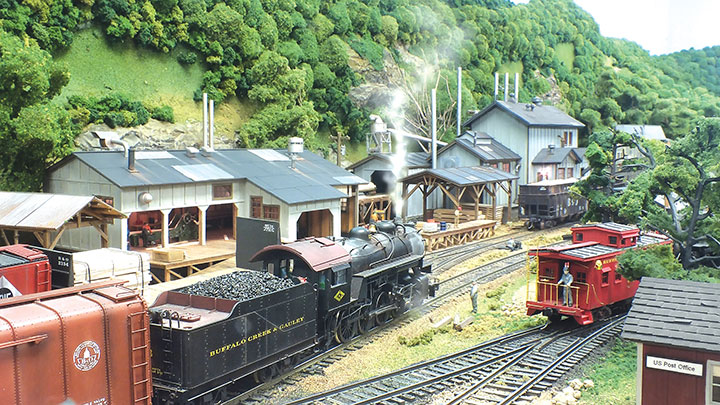
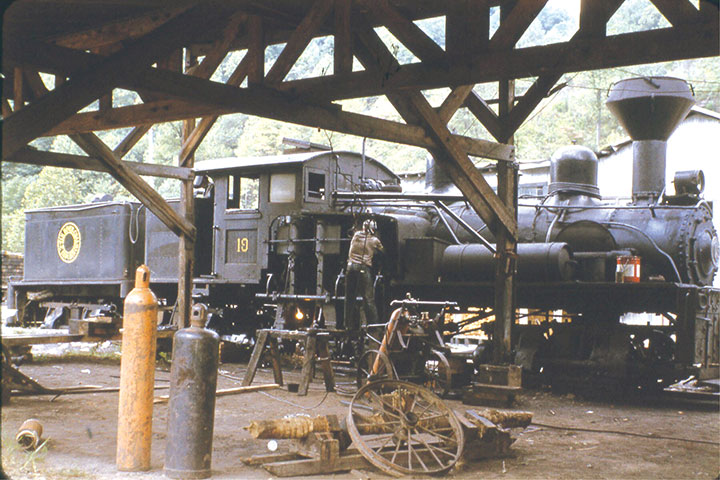
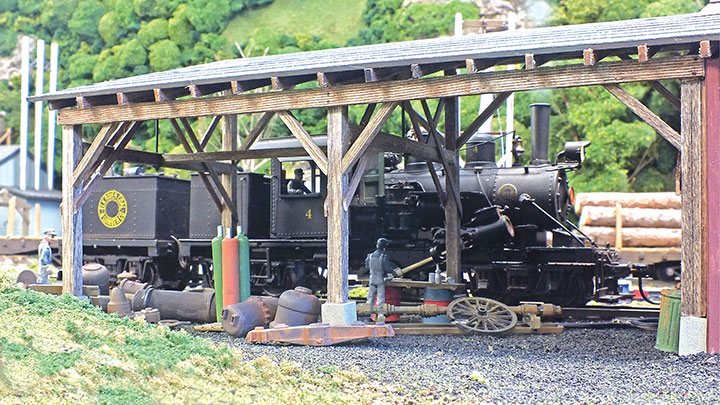
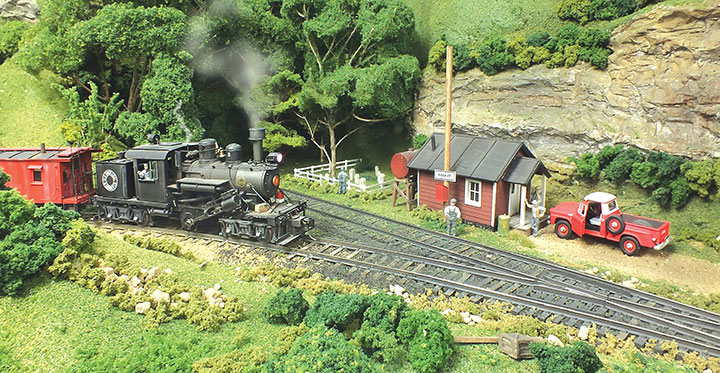
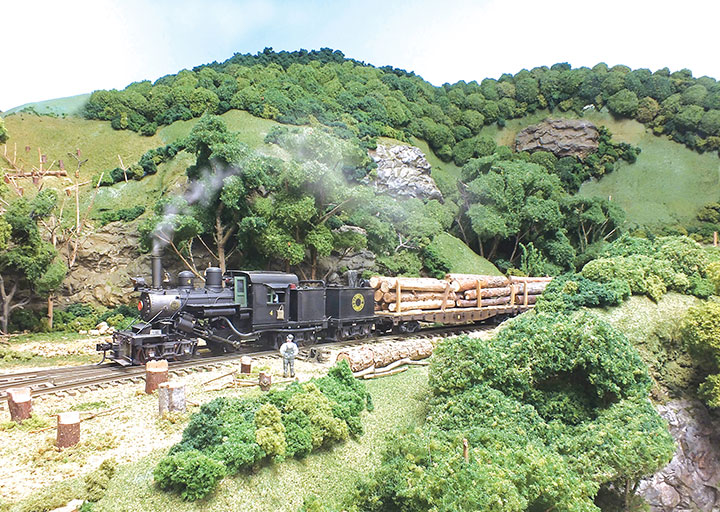
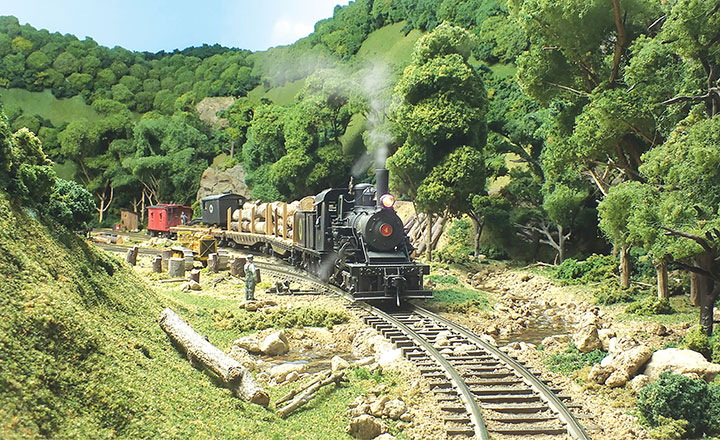
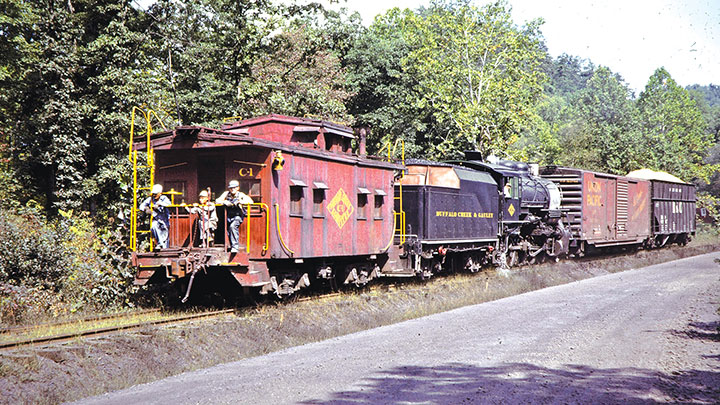
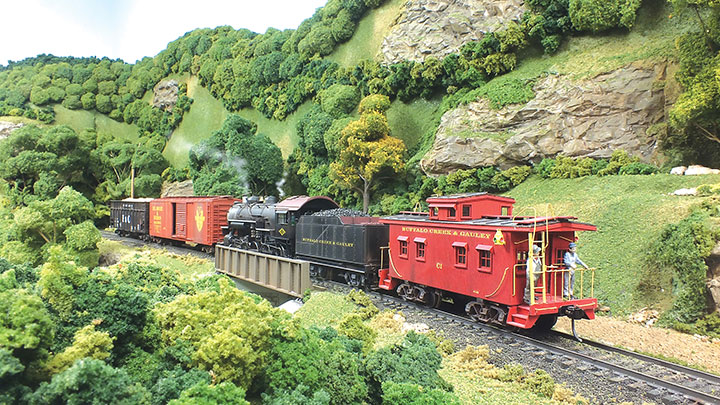
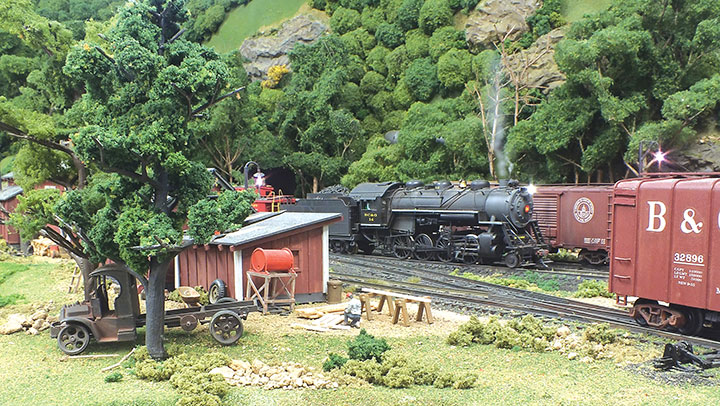
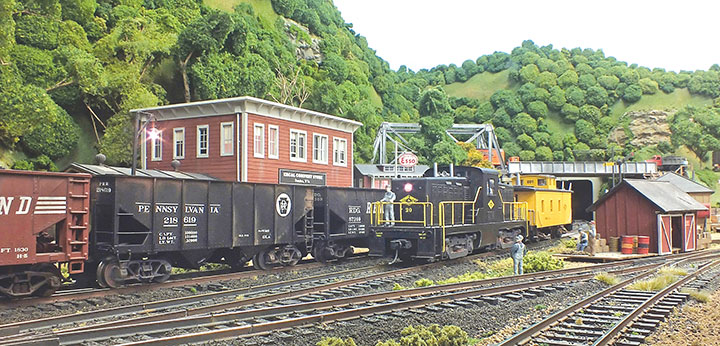
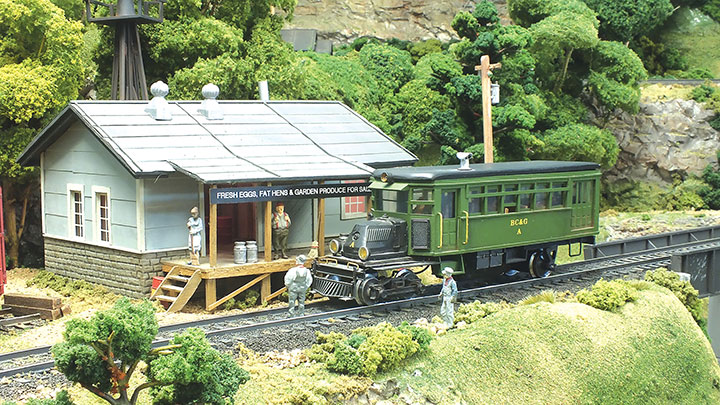
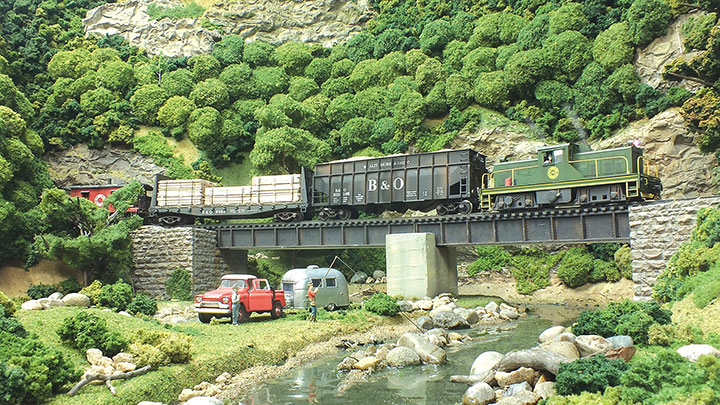
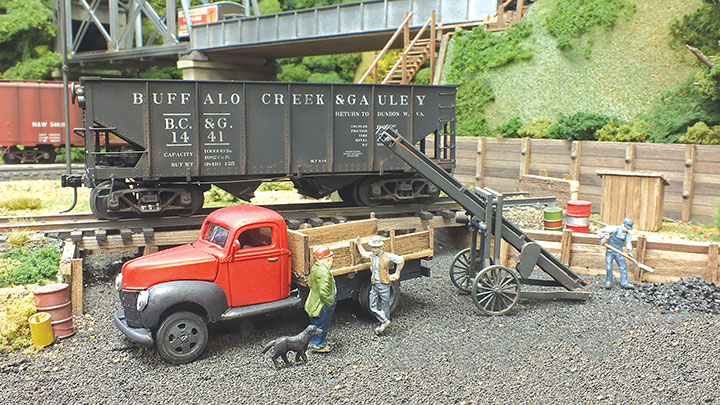

Construction Techniques And Features
Because we had our new home built to our specifications, I was able to optimize the configuration of the layout room. I had the builder install wall outlets where I wanted and specified one circuit on a wall switch which now shuts off power to the layout. I had the builder hang florescent light fixtures to brightly light the layout, carpet the floor and even paint the walls sky blue. I then added the stenciled clouds before starting benchwork construction.
Building a new layout from scratch offered the opportunity to try some of the new materials and techniques that have become available since I started my prior layout 20 years earlier. But I also used some old tech. For starters, I recycled much of the benchwork lumber from the prior layout. Because I had the new layout design well along before tearing down the old one, I was able to cut some of the lumber to length at the old house. This sped up construction of the new layout and allowed me to use superior fully-seasoned older lumber for much of the new supporting benchwork. The Masonite sliding doors installed below the layout, were also moved from the prior layout, as were the hillside profiles attached to the walls. I installed 110-volt power outlets at several locations on the fascia to minimize the need for extension cords during construction and maintenance.
For the sub-roadbed and scenery, I went new tech. For the flat areas, I used 1½-inch extruded foam on top of a lattice of 1- x 2-inch clear pine supported on risers. After some experimentation, I found the noise levels excessive, and so added ½-inch-thick Homasote on top of the foam. I used Woodland Scenics foam risers for the grade between the two levels of the layout. I laid Fox Valley Models’ new code .138 S track and turnouts on cork roadbed, laid on the Homasote. I was extremely happy with NCE’s wireless DCC on the prior layout, and so simply upgraded my system for the new one.
For the steep hillsides, I developed a no-plaster, mess-free technique for creating hard shell. Using hot melt glue, I attached plastic sun-shade screening material to profiles made of ½-inch-thick foam. I then applied a thick layer of Homax brand texture paint that when dried created a surface to which rock castings and a forest canopy were attached. All of the rock castings, poly-fiber trees, and clump foliage, and all of the foreground trees were reused from the prior layout.
Conclusion
Forty years ago, I had no way of knowing that a mere 18 miles of railroad plus a logging branch would provide me so many hours, over so many years, of thoroughly satisfying model railroading. Soon I will have been modeling the BC&G for as many years that the prototype operated. So far, my fourth layout has met or exceeded my expectations. I’m so glad the BC&G downsized in 1963, and that I decided to model the shortened BC&G and ERC&L railroads and model them in S scale. While I’ve made great progress, I have a list of projects that will keep me busy for many more years. What more could I ask of a couple of little railroads?